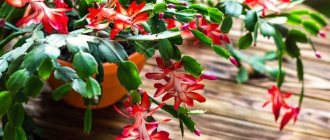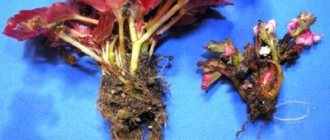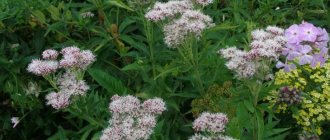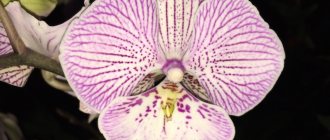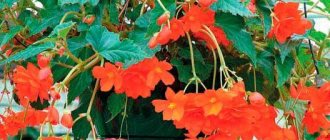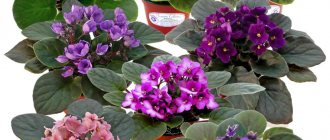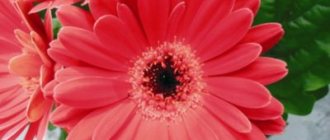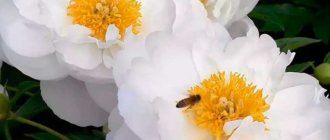Billbergia is a beautifully flowering, evergreen plant from the bromeliad family. Forms a rosette of wide, belt-shaped leaves in the center of which moisture accumulates.
During flowering, it produces straight peduncles with drooping inflorescences. The height of the plant does not exceed 60-70 cm. The birthplace of Bilbergia is Brazil. The culture is a typical epiphyte. Under natural conditions it grows only on trees; special substrates are used for growing indoors. The average life expectancy, provided the necessary conditions are created, reaches 5-8 years.
Also be sure to look at a flower from the same family - Aechmea.
| The growth rate is high. |
| Blooms from early winter to early spring. |
| The plant is easy to grow. |
| It is a perennial plant. |
Briefly about bromeliads
You may be interested in: Clematis Omoshiro: growing at home
It would seem like one family, but such different plants belong to it! For example, a pineapple - it also belongs to the bromeliad family. And to look at him and the drooping Billbergia (photo below) - well, nothing in common!
You may be interested in:Anthurium has brown spots on the leaves: what to do with the flower, methods for solving the problem and care tips
However, this is only at first glance. In fact, all representatives of bromeliads have common features by which you can immediately recognize “one of your own”. This is the very dense texture of the leaves, as well as the shape in which they are collected - in the form of a funnel. In it, such plants accumulate water; a similar ability arose in them during the process of evolution after dry periods.
There are more than three thousand bromeliads; they are divided into lithophytes (terrestrial) and epiphytes (plants that settle on other plants, but they are not parasites, they simply survive in this way - they cannot do otherwise due to a weak root system). Along with pineapple and some other representatives of the bromeliad family, Billbergia drooping is one of the most common indoor plants.
Short description
Billbergia is an epiphyte, meaning it lives on other plants. In the wild, it prefers to live in tropical rainforests. Like other bromeliads, it is a herbaceous perennial, but in all other respects it is a completely atypical representative of the family. But it is very unpretentious - caring for drooping Billbergia is absolutely easy, and perhaps that is why they are so fond of purchasing it to decorate their home. By the way, it is believed that Billbergia brings harmony to the home.
You may be interested in:Hydroponics at home: necessary equipment, tips for growing and caring for plants
Billbergia drooping also differs from other plants in that it blooms not in the summer, like the vast majority, but in the cold period - from October to January. Thus, it seems to warm its owner in the most persistent and severe frosts, giving warmth and a reminder of the hot, colorful summer.
Water
In order to know how to water a flower, follow simple rules. Use rainwater at room temperature or distilled because this rainforest native is sensitive to chlorine and fluoride added to tap water. Water the soil just enough to keep the roots barely moist.
If you water centrally, be sure to regularly rinse the center bowl to remove accumulated salts. But in general, it is sufficient to water these plants through the soil weekly during the growing season and reduce watering during the winter dormancy period. Never leave a plant in standing water.
Epiphytic plants grown outside of soil require more constant watering; Water them once a day and give them a good soak by submerging them in water once a week.
Appearance
Like other members of the family, the Billbergia flower has dense leaves collected in a funnel. At the same time, in other respects, the leaves of this plant are noticeably different from the leaves of other bromeliads: in Bilbergia they are narrow, long and seemingly pointed. To the touch they are covered with scales, and on the sides - as if with thorns. Some are the same color, and some are different (and we are still talking about the leaves, and not about the flowers themselves). As for the flowers, or inflorescences, they, as is clear from the name of the plant itself, are drooping, that is, with their “heads” lowered. At the same time, they seem to be twisted into a small tight spiral, reaching twenty to thirty centimeters. Their color is very unusual and original - dove-blue at the edges, towards the center it turns into yellow-green-pink. The bracts of Billbergia drooping (or drooping, by the way) are very beautiful: bright fuchsia color.
Billbergia is quite small in size - half a meter maximum in height. But it grows greatly in width, which is why it gives the impression of a huge bush.
Types of Billbergia domestica with photos and names
The most common types in indoor floriculture are:
Billbergia nutans
The leaves are belt-shaped, up to 70 cm long, rich green in color; with a lot of bright sunlight, their surface turns pink. The leaf plates are collected into a large, tubular rosette. Inflorescences of drooping type with long bracts.
Billbergia pallidiflora
An epiphyte that grows naturally on rocky slopes. The leaves are few in number, collected in a powerful, tubular rosette. The leaf blades are bright green, rough, with numerous spines along the edges. The peduncle is curved with a spike-shaped, densely pubescent inflorescence.
Billbergia magnifica
The leaves are few in number and form a powerful, tubular rosette. The leaves are green, linear, up to 70 cm long. The inflorescence is spike-shaped with blue flowers. The bracts themselves are very large, rich pink.
Billbergia zebra or Billbergia zebrina
An epiphyte with long leathery leaves with characteristic white stripes. The flowers are blue, with large pink bracts.
Origin story
Billbergia was first discovered in the eighteenth century, and this discovery was made by a Swedish scientist, botanist named Billberg. While traveling through the forests of Central and South America, Gustav Billberg noticed an unusual, never-before-seen plant of amazing beauty. Billbergia, described by the scientist in his diary, was brought to Europe, and from there it began its victorious march around the world. A little later, it received its name - of course, after the name of its discoverer. By the way, Bilbergia also has, so to speak, a popular name - “queen’s tears.” The thing is that the flower secretes nectar, which drips from the drooping inflorescences of the plant like real tears. Initially, breeding Billbergia was available only to the wealthy segments of the population and was very fascinating to them. Now everyone can grow this flower on their windowsill.
Billbergia drooping: home care
You may be interested in: Pineapple in a pot: planting, care, watering features, photo
It has already been said above that the plant we are interested in is extremely unpretentious, and this is true. It is also very loyal and will easily forgive its owner for small mistakes in taking care of itself, so it is perfect for beginning amateur flower growers. This is a very hardy plant, and even super-busy people with tight work schedules who are not able to devote much time to the flower will be amazed at how quickly this beauty will bloom for them. An important point: Billbergia perfectly adapts to any living conditions, to any climate, so it can be grown both in the Kuban and in cold Siberia.
Next, let's talk about how to properly care for this tropical flower.
How to grow
We are accustomed to the fact that all indoor plants live in decorative pots, and this is logical. However, we should not forget that Billbergia is an epiphyte that settles on other trees, as well as just snags. Therefore, you can grow this flower on the so-called bromeliad tree - in other words, on a large branched snag. It’s not difficult to place a billbergia there: you just need to pull the flower out of the pot, clean the roots from the soil, wrap it in sphagnum moss, and then tie it to a snag. There is only one downside to this arrangement - the tree is still quite impressive in size, so the room where it will be located must be quite spacious. However, this drawback can be circumvented: in small rooms, instead of wood, a small block of wood is simply attached to the wall. It looks quite impressive, and caring for Billbergia in this case comes down solely to maintaining the proper moisture content of the moss.
When does it bloom?
Most gardeners give their preference to Billbergia for its unique beauty during the flowering period. And given the unpretentiousness and endurance of this plant, even novice gardeners can grow it.
The flowering period depends on the type of billbergia. Pyramid and green flowers bloom mainly from the beginning of spring and almost all summer. The magnificent one prefers summer, and the drooping one prefers winter.
Sometimes gardeners are faced with a problem such as a long, many-year absence of a flowering period for a given plant. This may be due to some violations in caring for Billbergia.
Let's consider the basic rules, the observance of which will allow you to enjoy beautiful flowers for a long time:
The soil is preferably peat-leaf, loose. You can add moss and a little river sand to it. The pH should be in the range of 5.0-5.3. Ready-made mixtures that are sold for orchids are excellent for billbergia; choose a medium-sized pot, 25-30 cm; The watering regime must allow the soil to dry completely, otherwise the process of rotting will begin
Pay attention to the presence of moisture in the rosettes of leaves; if it is not there, then it’s time to water; the plant prefers air temperatures within +18-23*C;
- bright light can cause burns on the plant, so you should not place the pot on a south-facing window. At the same time, excessive shading will also have a bad effect on flowering;
- in the summer. It is very useful to move the plant from the apartment to the balcony; fresh air promotes active growth;
- It is advisable to spray billbergia daily, using soft water;
- the plant is exposed to pests such as thrips, mealybugs and spider mites. Getting rid of them is quite simple; just wash the plants with soapy water;
- The plant must be fed year-round. The ideal remedy is fertilizers specifically designed for bromeliads;
- replanting is necessary every year, after the flowering period;
- Billbergia can be propagated using seeds or side shoots longer than 15 cm.
This is all about proper care, but if you encounter such manifestations as drying tips of leaves, then there are clearly problems with watering and the plant is drying out.
If the leaf rosette has become loose and falling apart, then most likely there is a deficiency of light.
Lighting
When it comes to lighting, Billbergia definitely outperforms any other plants - the thing is that, in general, it doesn’t care at all what light conditions it grows in. She is equally pleased to live both on a sunlit window sill and in the depths of the apartment, where natural light barely penetrates.
However, like any other plant, Billbergia drooping has its own preferences. This is diffused light with shading from the midday sun. To achieve such lighting, it is best to place the flower on windows on the east and/or west side.
Does it bloom late?
Billbergias that do not bloom do not receive enough light. Move the plant to a brighter area. Moving it outside for the summer, a partially shaded area may be just what it needs.
You can encourage flowering by adding a pinch of Epsom salt (magnesium sulfate) to water or fertilizer.
Give it a boost to bloom with this simple trick: Place a ripe apple or several apples around the plant and put it all in a clear plastic bag for a week or two.
Ripening apples release ethylene, which promotes the formation of flower buds. Keep the plant out of direct sunlight while covered in plastic to prevent overheating.
Watering
Irrigation of Billbergia drooping, living in a pot, depends on the time of year. If it is summer, then a lot of water is required - so much so that the soil always remains slightly moist; however, it is important to ensure that there is no moisture stagnation. During this period, water is also sent into the funnel of the leaves. Important: after flowering, it is strictly forbidden to do this, since such an action can lead to rotting of the plant. In winter, the tropical beauty is watered less often, the soil is allowed to dry, and the leaves are left dry. Water for irrigation at any time of the year should be warm, standing for 24 hours (it is permissible to add acetic or citric acid to soften it).
If the billbergia lives on a bromeliad tree, then all that needs to be done is to remove the moss when it is completely dry and immerse it in a container of water for about twenty minutes. After this time, the moss is pulled out, excess moisture is allowed to drain and the sphagnum is returned to its place.
Pruning Billbergia
Bromeliad beauty develops with the constant replacement of faded rosettes, which are selected by young plants 1-2 months after flowering. Old rosettes must be cut off by hand 4-6 weeks after flowering ends. They will not only prevent the plant from maintaining its attractiveness, but will also “slow down” the growth of young children.
Substrate : for Billbergia you need to choose a rather specific soil mixture - coarse in texture, with a reduced proportion of turf soil. Pay attention to the pH indicators: they should be equal to 5.0 units. A mixture of high-moor peat, leaf soil, river sand, moss and humus is suitable for this plant.
Transplantation : not annual, but quite frequent (active growth requires timely separation and removal of children from the mother bush). There are no specific dates for the procedure: replant along with separation as necessary, as soon as there are too many children for this container, the roots will begin to crawl out of the drainage hole at any time convenient for you during the active growth period (from March to August, but not Later).
Containers for bilbergia : due to the fact that this plant actively forms young rosettes and grows, you can choose only large vessels. But they should be wide and not too deep. In addition to containers, Billbergia can be grown on tree bark or driftwood (following the principle of other epiphytes and orchids), but only if the plant was initially accustomed to such conditions and you purchased it on bark.
Billbergia drooping. © Elizabeth
Temperature and humidity during care
Billbergia loves warmth, but not heat. During the active period, you need to make sure that the room is warmer - within 25-28 degrees, during the rest period - cooler, from 15 to 18 degrees. The latter is a must, since it is the coolness that stimulates the development of the kidneys. However, you should not be zealous and lower the temperature too much: Billbergia nutans (this is the Latin name of the flower) may get sick and die.
Air humidity should be maintained between 70-80 percent. If it’s summer outside or the room is always hot and dry, the flower should be sprayed regularly (except for the flowering period). If the plant lives in a pot, you can place the flowerpot on a tray with water.
Is it possible to keep this plant at home?
Many people are concerned about the question: is it possible to keep this plant at home? Of course you can! But since these flowers were born in southern countries, we must remember the following rules:
- Illumination. The light should be diffused. The scorching rays of the sun lead to burns, so the flower must be protected from them. In winter, when there is very little daylight, it is worth taking care of additional lighting.
- Air. It must be fresh. The room where the bush is located is systematically ventilated. However, drafts should be avoided. Bromeliads don't like them!
- Temperature. The best option is from 20 to 25 degrees. In winter, this figure drops to 18-19 degrees. The main thing is that the plant does not stay at critically low temperatures for a long time.
- Watering mode. When it's warm, water every day. This can be done in two ways: either pour water into the ground as a dry crust appears, or pour it into a leaf funnel. The last method is very difficult for a beginner; you will have to practice first. With the onset of cold weather, the frequency of watering decreases to once a week. Regardless of the situation, always add water to the pan!
- Air humidity. It should not be lower than 70 percent. To maintain it at this level, you can place a vessel with water next to the flower pot or purchase a special humidifier. It is also good to spray the leaf mass with water. (Regular tap water contains a lot of chlorine. Let it sit for two days and then safely use it). Once a week, the leaves should be wiped from dust so that they can breathe fully.
- Fertilizers. Any mineral will do. Feeding schedule: in spring and summer regularly every three weeks. In winter, we reduce the frequency to 1 time every 6 days. Add the solution directly to the soil or spray it onto the green mass.
- Transfer. Performed when the roots become too crowded in the pot. This usually happens every 2-3 years. There are no difficulties in this procedure.
- Reproduction. Between February and April, small shoots appear on the bush. In two to three months they will be ready for independent living. To do this, carefully cut them off at the base with a disinfected knife. Treat the cut area with crushed coal. Plant in moist soil. In two years the new bush will begin to bloom. All plants of this family have one feature - after flowering they die. But it normal! By this time, the bushes have already sprouted, so there is no need to worry.
Feeding
What other care is needed for Drooping Billbergia at home? In the photo you can see beautiful, pleasing flowers. This result can be achieved if you feed the southern guest correctly and in a timely manner. This should be done exclusively during the growing season.
Once every fourteen days at this time, you should supply the flower with fertilizers for bromeliads; similar ones for orchids are also suitable, but in half the dose. The main thing is that the fertilizing contains a minimum of nitrogen, since too much nitrogen can lead to the death of the plant.
The soil
As for the soil, there are no special claims here. The main thing is that it is crumbly enough so that water and air penetrate well through it. There are special soils for bromeliads, which can also be used for planting billbergia (pictured).
Caring for it, as you can see, is not too burdensome. And in response to care and attention, the green pet will certainly delight the owner with original inflorescences.
However, let's return to the soil. According to experienced flower growers, it is also possible to prepare the soil yourself: you need to mix leaves, peat, humus in proportion, add a little chopped moss and sand. The drainage layer of the substrate must be very good.
Fertilizer
Indoor care involves feeding every 2 weeks in spring and summer with a balanced water-soluble fertilizer diluted by half. In autumn and winter, feed once a month.
If desired, use foliar fertilizer. As you already know from the description of the flower, they absorb moisture and nutrients through the leaves, so you can add fertilizer to the water and spray it on the leaves.
Reproduction and transplantation
Billbergia drooping has a lot of “offsprings” - branch sprouts. The easiest way to propagate a plant is with their help. You can separate them from the nodal part during transplantation, and the young shoots will bloom approximately a couple of years after rooting. Another option is to divide the adult flower; in this case, flowering can be expected as early as next year. There is a third method: seed propagation, but it is the most difficult and is suitable, perhaps, for the most patient people, since it involves following special technologies for germinating seeds and breeding the sprouts themselves.
As for replanting, this should only be done when the previous pot of Bilbergia becomes small. The thing is that the root system of the plant is not only weak, but also small and slowly developing. “Transplantation,” as a rule, is accompanied by the division of an overgrown flower, and flowerpots and other vessels for plants need to be selected in such a way that they are wide enough (and their depth is not at all necessary).
Reproduction of Billbergia by lateral shoots
The easiest way to reproduce. During the growth process, Billbergia forms numerous side shoots that can be used for propagation. They are separated during the annual transplant. The larger the divisions, the faster and easier they take root.
After separation, the cut sites are treated with charcoal powder. Young plants are planted in soil mixture for adults in small greenhouses. You can also root in crushed moss or perlite. In this case, after the roots develop, additional transplantation into a full-fledged substrate will be required.
In conditions of high humidity, plants take root much faster. To stimulate the development of roots, divisions can be dipped in Kornevin powder before planting. They bloom after 2-3 years of cultivation.
Diseases and pests
Parasites such as aphids, spider mites, mealybugs and scale insects can harm Billbergia drooping. All of them can be removed quite easily with the help of insecticides, which should be used to treat the entire billbergia (an insecticide of any appropriate action is suitable).
As for diseases, drooping Billbergia is susceptible to the following misfortunes: drying of the tips of the leaves in the absence of water in the funnel, rotting of the plant due to waterlogging, and the appearance of light brown spots due to sunburn. In addition, if there is not enough light, the leaves may become too loose and their funnel will fall apart. To prevent any of this from happening, you just need to properly care for the plant.
This is information about an unusual tropical plant - drooping billbergia.
Source
Growing Billbergia from seeds
To grow Billbergia from seeds, you must adhere to the following rules:
- Seeds are sown immediately after collection.
- Before sowing, the seeds are disinfected in a light pink solution of potassium permanganate.
- Sowing is carried out in a mixture of peat and crushed sphagnum moss.
- The sowing container must be covered with film and placed in a dark, warm place with a temperature not lower than +23°.
- The greenhouse must be ventilated periodically.
The first shoots appear after 1-1.5 months. After the seedlings form 2-3 true leaves, they are planted in separate pots. In the future, they are cared for in the same way as adult plants.
